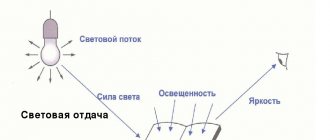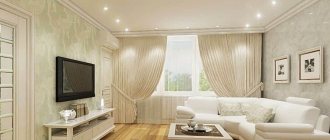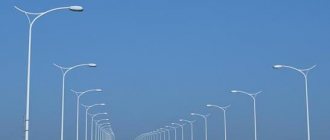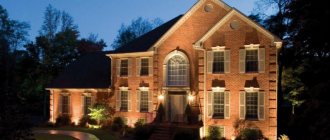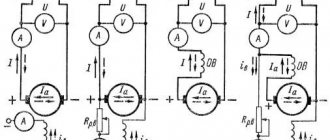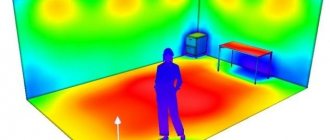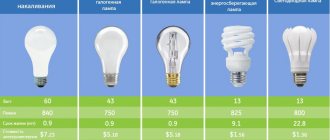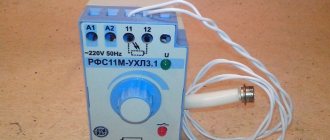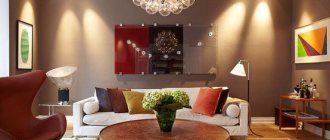General information
Illuminance is a luminous quantity that determines the amount of light falling on a certain surface area of the body. It depends on the wavelength of light, since the human eye perceives the brightness of light waves of different lengths, that is, different colors, in different ways. Illuminance is calculated separately for different wavelengths, since people perceive light with a wavelength of 550 nanometers (green), and colors that are nearby in the spectrum (yellow and orange), as the brightest. Light produced by longer or shorter wavelengths (violet, blue, red) is perceived as darker. Illumination is often associated with the concept of brightness.
Illumination is inversely proportional to the area on which the light falls. That is, when illuminating a surface with the same lamp, the illumination of a larger area will be less than the illumination of a smaller area.
Difference between brightness and illuminance
BrightnessIllumination
In Russian, the word “brightness” has two meanings. Brightness can mean a physical quantity, that is, a characteristic of luminous bodies, equal to the ratio of the intensity of light in a certain direction to the area of projection of the luminous surface onto a plane perpendicular to this direction. It can also define a more subjective concept of overall brightness, which depends on many factors, such as the eyes of the person looking at the light or the amount of light in the environment. The less light there is, the brighter the light source appears. In order not to confuse these two concepts with illumination, it is worth remembering that:
brightness
characterizes the light
reflected
from the surface of a luminous body or sent by this surface;
illumination
characterizes
incident
on the illuminated surface.
In astronomy, brightness characterizes both the emitting (stars) and reflecting (planets) ability of the surface of celestial bodies and is measured on the photometric scale of stellar brightnesses. Moreover, the brighter the star, the lower the value of its photometric brightness. The brightest stars have a negative stellar brightness value.
Units
Illuminance is most often measured in SI units of lux.
.
One lux is equal to one lumen per square meter. Those who prefer imperial units to metric units use the foot-candle
. It is often used in photography and cinema, as well as in some other areas. The foot in the name is used because one foot-candela refers to the illuminance of one candela on a surface of one square foot, measured at a distance of one foot (just over 30 cm).
Exposure meter "Sverlovsk-4", made in the USSR in the 80s
Photometer
A photometer is a device that measures light. Typically, light is sent to a photodetector, converted into an electrical signal, and measured. Sometimes there are photometers that work on a different principle. Most photometers display illuminance information in lux, although other units are sometimes used. Photometers, called exposure meters, help photographers and cinematographers determine shutter speed and aperture. In addition, photometers are used to determine safe lighting in the workplace, in crop production, in museums, and in many other industries where it is necessary to know and maintain a certain lighting level.
Lumen, hatch, candela, stick, luminous flux. What does it mean?
In other words, luminous intensity is the amount of light available to the human eye. To convert emitted energy (Watts) into luminous flux (Lumens), you need to know the emission wavelength and human sensitivity curve.
It follows that monochromatic radiation as a computer problem is solved completely irrelevant, but for LED light white you also need to know a more detailed range of emissions and production technologies, and only from this data calculation methods have already been developed.
| Emission color | Formula for calculating light flux into radiation energy | Optician turn on power Fv = 100 lumnov, W | Light intensity at P = 1 W, lm |
| red 650 nm | P = Fv / 68.3 W / lm | 1:46 | 68,3 |
| orange 625 nm | P = Fv / 222 W / lm | 0,45 | 222 |
| green 555 nm | P = Fv / 683 W / lm | 0,15 | 683 |
| blue 465 nm | P = Fv / 68.3 W / lm | 1:46 | 68,3 |
| white | P = Fv / 243 W / lm | 0,41 | 243 |
So we can see that 1W white LEDs up to 100lm/W efficiency emit 0.4W and 0.6W of light as heat, while a 100W lamp only consumes 6W visible light broadcast (0 .06 W 1 W).
The energy consumed by the light source from the power supply is not completely converted into radiation.
This is especially true for LED lamps. In addition to energy losses in the LED itself, the power converter loses its power, and some of the light is blocked by optics - reflectors, dispensers, lenses. When using a 100 lm/W LED, luminaire efficiency rarely reaches 80 lm/W, and for the most common light sources it can be 60-70 lm/W. Because of this, modern LED light sources are about 10 times more efficient than the now archaic incandescent lamps.
In this case, do not forget the main rule for designing a power supply for an LED: use a current stabilizer to power the LED, do not mix it with a voltage regulator. In the case of low currents, the LM317T chip has proven to be very useful, and for large currents, specialized driver microchips that perform optimal current operation are especially important, especially critical for high power.
To find out how many lumens are in a candle, you need to use a simple web calculator.
Illumination in photography and videography
Video shooting
Most modern cameras have built-in exposure meters, making the work of the photographer or operator easier. An exposure meter is necessary so that the photographer or operator can determine how much light needs to be let into the film or photo matrix, depending on the illumination of the subject being photographed. Illumination in lux is converted by the exposure meter into possible combinations of shutter speed and aperture, which are then selected manually or automatically, depending on how the camera is configured. Typically, the combinations offered depend on the settings in the camera, as well as what the photographer or cinematographer wants to depict. Studios and film sets often use an external or in-camera light meter to determine whether the light sources being used provide sufficient illumination.
To take good photographs or video in poor lighting conditions, sufficient light must reach the film or sensor. This is not difficult to achieve with a camera - you just need to set the correct exposure. With video cameras the situation is more complicated. To shoot high-quality video, you usually need to install additional lighting, otherwise the video will be too dark or with a lot of digital noise. This is not always possible. Some camcorders are specifically designed for shooting in low light conditions.
Cameras designed for shooting in low light conditions
Cell phone camera and lens
There are two types of cameras for low-light photography: some use higher-end optics, and others use more advanced electronics. The optics let more light into the lens, and the electronics better handle even the little light that gets into the camera. It is usually electronics that cause the problems and side effects described below. High-aperture optics allow you to shoot higher-quality video, but its disadvantages are additional weight due to the large amount of glass and a significantly higher price.
1/1.7 inch (7.60 x 5.70 mm) CCD lens and image sensor for compact camera
In addition, the quality of shooting is affected by the single-matrix or three-matrix photomatrix installed in video and photo cameras. In a three-matrix array, all incoming light is divided by a prism into three colors - red, green and blue. Image quality in dark conditions is better in three-array cameras than in single-array cameras, since less light is scattered when passing through the prism than when it is processed by the filter in a single-array camera.
There are two main types of photomatrices - charge-coupled device (CCD) and those based on CMOS (complementary metal oxide semiconductor) technology. The first usually contains a sensor that receives light and a processor that processes the image. In CMOS sensors, the sensor and processor are usually combined. In low-light conditions, CCD cameras generally produce better images, while CMOS cameras have the advantage of being cheaper and consuming less power.
Full-format 24 x 36 mm CMOS photo sensor for the Canon 5D Mark II professional digital SLR camera
The size of the photo matrix also affects image quality. If shooting takes place with a small amount of light, then the larger the matrix, the better the image quality, and the smaller the matrix, the more problems with the image - digital noise appears on it. Large matrices are installed in more expensive cameras, and they require more powerful (and, as a result, heavier) optics. Cameras with such matrices allow you to shoot professional video. For example, recently a number of films have appeared entirely shot on cameras such as the Canon 5D Mark II or Mark III, which have a matrix size of 24 x 36 mm.
Manufacturers usually indicate the minimum conditions in which the camera can operate, for example, with illumination of 2 lux or more. This information is not standardized, that is, the manufacturer decides for himself which video is considered high-quality. Sometimes two cameras with the same minimum illumination level produce different shooting quality. The Electronic Industries Association (EIA) in the United States has proposed a standardized system for determining the light sensitivity of cameras, but so far it is used only by some manufacturers and is not universally accepted. Therefore, in order to compare two cameras with the same light characteristics, you often need to try them in action.
At the moment, any camera, even one designed for low-light conditions, can produce low-quality images with high grain and afterglow. To solve some of these problems, you can take the following steps:
If there is not enough light and the subject is static, the best results are obtained if you mount the camera on a tripod
- Shoot on a tripod;
- Work in manual mode;
- Do not use zoom mode, but instead move the camera as close to the subject as possible;
- Do not use automatic focusing and automatic ISO selection - with a higher ISO value, noise increases;
- Shoot at a shutter speed of 1/30;
- Use diffused light;
- If it is not possible to install additional lighting, then use all possible light around, such as street lamps and moonlight.
Although there is no standardization about cameras' sensitivity to light, for night photography it is still best to choose a camera that says it operates at 2 lux or lower. Another thing to remember is that even if a camera is really good at shooting in dark conditions, its light sensitivity, listed in lux, is sensitivity to light directed at the subject, but the camera is actually receiving light reflected from the subject. When reflected, part of the light is scattered, and the further the camera is from the object, the less light enters the lens, which deteriorates the quality of shooting.
How to choose the right lamps depending on the number of lumens
Calculating illumination in lumens is not difficult if you use the recommendations from SNiP and remember a few tips:
- Sanitary lighting standards have been established for each room. For bathrooms, toilets, utility rooms, corridors and hallways the figure is 50 Lx. For living rooms and kitchens it is 150 Lx. In children's rooms and play areas, at least 200 lux are needed. Workrooms, home offices and libraries are illuminated at a standard of 300 lux.
- The selected norm must be multiplied by the area of the room. The result will show the total illumination needed for a particular room. This indicator is worth focusing on.
- The number of light bulbs and their location are thought through. For small rooms, a chandelier in the middle will suffice, distributing the light evenly. And if the room is large or elongated, it is better to use more lamps with lower brightness and arrange them evenly or install 2-3 chandeliers.
It is not difficult to calculate the optimal luminous flux in lumens if you know the ratio of this indicator to the power of the main types of lamps. When choosing equipment, you must remember that you cannot greatly exceed the recommended standards.
Exposure number
The same photo with different exposure numbers
Exposure number
(English Exposure Value, EV) is an integer characterizing possible combinations of
shutter speed
and
aperture
in a photo, film or video camera. All combinations of shutter speed and aperture that expose the same amount of light to the film or sensor have the same exposure number.
Several combinations of shutter speed and aperture in the camera at the same exposure number allow you to obtain an image of approximately the same density. However, the images will be different. This is due to the fact that at different aperture values, the depth of the imaged space will be different; at different shutter speeds, the image will remain on the film or matrix for different times, as a result of which it will be blurred to varying degrees or not blurred at all. For example, the combinations f/22 - 1/30 and f/2.8 - 1/2000 are characterized by the same exposure number, but the first image will have a large depth of field and may be blurry, and the second will have a shallow depth of field and, quite possibly , will not be blurry at all.
In the left photo, due to the long shutter speed, the movement of the water is emphasized, while in the right photo, due to the relatively short shutter speed, the movement is not so noticeable and the water is depicted sharply
Higher EV values are used when the subject is better lit. For example, an exposure value (at ISO 100) of EV100 = 13 can be used when shooting landscapes if the sky is cloudy, and EV100 = –4 is suitable for shooting bright aurora.
A-priory,
EV = log2( N
2/
t
)
or
2EV = N
2/
t
, (1)
- Where
- N
- aperture number (for example: 2; 2.8; 4; 5.6, etc.) - t
- shutter speed in seconds (for example: 30, 4, 2, 1, 1/2, 1/4, 1/30, 1/100, etc.)
Dependence of depth of field on aperture value at the same exposure number
For example, for a combination of f/2 and 1/30, the exposure number
EV = log2(22/(1/30)) = log2(22 × 30) = 6.9 ≈ 7.
This number can be used to shoot night scenes and illuminated storefronts. Combining f/5.6 with a shutter speed of 1/250 gives the exposure number
EV = log2 (5.62/(1/250)) = log2 (5.62 × 250) = log2 (7840) = 12.93 ≈ 13,
which can be used to shoot a landscape with a cloudy sky and no shadows.
It should be noted that the argument of the logarithmic function must be dimensionless. In determining the exposure number EV, the dimension of the denominator in formula (1) is ignored and only the numerical value of the shutter speed in seconds is used.
The same exposure number 12 is installed on a Zenit-ET film camera and a Canon 5D Mark II digital camera
Typical illumination, examples
The interpretation of the illumination unit 1 lux looks like this: 1 lux (the designation of this value in the SI system) corresponds to the order of illumination of 1 m2 of surface by an incident light flux of 1 lumen (Lm).
When it comes to the brightness of light, there are two positions to consider:
- the strength of light emitted by any source;
- the amount of light falling on the surface.
The second position is the illumination in question.
Examples of typical illumination values, in accordance with external perception
| Illumination value, lux | External perception |
| 0,0001 | moonless starry sky |
| 0,01 | quarter moon |
| 0,27 | full moon in a clear sky |
| 1 | the ability to distinguish the outlines of objects, free orientation in space, a short time for vision adaptation when moving from a brightly lit space |
| 5 | easy visual perception of the watch dial, the ability to read newspaper headlines |
| 10 | illumination of the space next to the candle |
| 15-20 | light from a cigarette at a distance of 300 mm |
| 20-35 | light in the cinema during intermission |
| 50 | you can read the text in the newspaper, lighting the living room |
| 100 | allows for long periods of newspaper reading, but is tiring for the eyes |
| 300 | comfortable conditions for reading printed materials |
| 400-500 | typical lighting for libraries and offices |
| 1000 | clear day an hour before sunset |
| 2000 | clear morning an hour after sunrise |
| 25000 | summer cloudy day at 10 am |
| 65000 | clear summer day at 10 o'clock in the morning |
| 100000 | midday on a clear summer day |
Attention! The determination of the illumination of objects is not limited to visual perception. For this purpose, a device called a “lux meter” is used. This is a simple device based on a photocell that converts light energy into electrical energy and displays the readings on the display
It allows you to measure illumination
This is a simple device, which is based on a photocell that converts light energy into electrical energy and displays the readings on the display. It allows you to measure illumination.
Luxmeter CEM DT 1308
The relationship between the exposure number and the brightness and illumination of the subject
Determining exposure by the brightness of light reflected from the subject
Determining exposure by measuring the light reflected from the subject with a lux meter
When using exposure meters or lux meters that measure light reflected from the subject, shutter speed and aperture are related to the brightness of the subject as follows:
N
2/
t
=
LS
/
K
(2)
Here
- N
- aperture number; - t
— shutter speed in seconds; - L
is the average brightness of the scene in candelas per square meter (cd/m²); - S
- arithmetic value of photosensitivity (100, 200, 400, etc.); - K
is the exposure meter or lux meter calibration factor for reflected light; Canon and Nikon use K=12.5.
From equations (1) and (2) we obtain the exposure number
EV = log2( LS
/
K
)
or
2EV = LS
/
K
At K
= 12.5 and ISO 100, we have the following equation for brightness:
2EV = 100 L
/12.5 = 8
L
L
= 2EV/8 = 2EV/23 = 2EV–3.
This formula is used in the converter to convert exposure number to cd/m² and vice versa.
Determining exposure based on the illumination of the subject (incident light)
Determining exposure by measuring the light falling on the subject with a lux meter
When using exposure meters or lux meters that measure the light falling on the subject, shutter speed and aperture are related to the illumination of the subject by the following relationship:
N
2/
t
=
ES
/
C
,
Where
- N
- aperture number; - t
— shutter speed in seconds; - E
is the average scene illumination, measured in lux; - S
- arithmetic value of photosensitivity (100, 200, 400, etc.); - C
is the exposure meter or lux meter calibration factor for reflected light; Typically C = 250 is used.
At C = 250 and ISO 100, we obtain the following dependence of the exposure number on the illumination of the subject:
2EV = ES
/
C
= 100/250
E
= 0.4 ×
E
E
= 2.5 × 2EV.
This formula is used in the illuminance converter to convert exposure number to lux and vice versa.
It should be noted that if you look at the table of correspondence between exposure numbers and brightness (for ISO 100 and K = 12.5) and illumination (for ISO 100 and C = 250) of the subject, you might think that it allows for direct conversion of cd/m² to lux and vice versa. However, this is not true, since lux measures illuminance, that is, the amount of light falling on a surface, while candelas per square meter. The meter is used to measure the brightness of an object, that is, the light reflected from the surface of the object. The amount of reflected light, that is, the brightness of an object, is determined by the properties of the object's surface and its texture. For example, a surface covered with black velvet may be illuminated by a very bright light source, but still have very low luminance. At the same time, a white car with a glossy surface can be brighter than black velvet in lower lighting conditions. Photographers know how difficult it is to photograph a model in a black velvet dress against a white car, and vice versa, a model in a white wedding dress against a black car.
Example of lighting conditions under which this exposure number can be used
| Brightness Converter | Illuminance converter | Example of lighting conditions under which this exposure number can be used | |||
| EV | cd/m² | fL | OK | ft cd | |
| -4 | 0,008 | 0,0023 | 0,156 | 0,015 | Bright aurora |
| -3 | 0,016 | 0,0046 | 0,313 | 0,029 | Landscape illuminated by moonlight, full moon |
| -2 | 0,031 | 0,0091 | 0,625 | 0,058 | Landscape illuminated by moonlight, full moon |
| -1 | 0,063 | 0,018 | 1,25 | 0,116 | Landscape illuminated by moonlight, full moon, light clouds |
| 0 | 0,125 | 0,036 | 2,5 | 0,232 | Poorly lit room |
| 1 | 0,25 | 0,073 | 5 | 0,465 | Buildings in the distance or a landscape silhouetted against the sky in low light |
| 2 | 0,5 | 0,146 | 10 | 0,929 | Buildings in the distance under artificial lighting |
| 3 | 1 | 0,292 | 20 | 1,86 | Architecture under artificial light |
| 4 | 2 | 0,584 | 40 | 3,72 | Christmas tree or streets illuminated with lanterns |
| 5 | 4 | 1,17 | 80 | 7,43 | Cars at night |
| 6 | 8 | 2,33 | 160 | 14,9 | Showcases at night |
| 7 | 16 | 4,67 | 320 | 29,7 | Night streets |
| 8 | 32 | 9,34 | 640 | 59,5 | Night streets with bright artificial lighting |
| 9 | 64 | 18,7 | 1280 | 119 | Fires, bonfires, sports under artificial lighting |
| 10 | 128 | 37,4 | 2560 | 238 | Neon advertising |
| 11 | 256 | 74,7 | 5120 | 476 | Landscapes just after sunset |
| 12 | 512 | 149 | 10240 | 951 | Landscapes during sunset or during heavy cloud cover |
| 13 | 1024 | 299 | 20480 | 1903 | Landscapes before sunset |
| 14 | 2048 | 598 | 40960 | 3805 | Landscapes in sunlight and heavily polluted atmosphere (fire smoke or exhaust fumes) |
| 15 | 4096 | 1195 | 81920 | 7611 | Landscapes in good sunlight |
| 16 | 8192 | 2391 | 163840 | 15221 | Snowy landscapes or desert in sunlight |
Read more about exposure number.
Determination of the luminous flux utilization factor η
This value does not need to be calculated; it can be found ready-made in tables, which greatly simplifies the process. But to use the information, you need one more coefficient - i, which is calculated by the formula:
i = Sp / ((a + b) × h)
Everything is simple here:
- Sp – room area in square meters;
- a is the length of the room;
- b – room width;
- h – distance from the floor to the lamp.
After determining the room factor, you can select data from the tables. Below are options for different light sources.
| Option for equipment located on the surface of the ceiling or suspended from it | ||||||||
| Reflection coefficient, % | Room factor i | |||||||
| Ceiling | 70% | 50% | 30% | |||||
| Walls | 50% | 30% | 50% | 30% | 10% | |||
| Floor | 30% | 10% | 30% | 10% | 10% | |||
| Luminous flux utilization factor | 0,26 | 0,25 | 0,20 | 0,19 | 0,17 | 0,13 | 0,06 | 0,5 |
| 0,3 | 0,28 | 0,24 | 0,23 | 0,2 | 0,16 | 0,08 | 0,6 | |
| 0,34 | 0,32 | 0,28 | 0,27 | 0,22 | 0,19 | 0,10 | 0,7 | |
| 0,38 | 0,36 | 0,31 | 0,30 | 0,24 | 0,21 | 0,11 | 0,8 | |
| 0,40 | 0,38 | 0,34 | 0,33 | 0,26 | 0,23 | 0,12 | 0,9 | |
| 0,43 | 0,41 | 0,37 | 0,35 | 0,28 | 0,25 | 0,13 | 1,0 | |
| 0,46 | 0,43 | 0,39 | 0,37 | 0,30 | 0,26 | 0,14 | 1D | |
| 0,48 | 0,46 | 0,42 | 0,40 | 0,32 | 0,28 | 0,15 | 1,25 | |
| 0,54 | 0,49 | 0,47 | 0,44 | 0,34 | 0,31 | 0,17 | 1,5 | |
| 0,57 | 0,52 | 0,51 | 0,47 | 0,36 | 0,33 | 0,18 | 1,75 | |
| 0,60 | 0,54 | 0,54 | 0,50 | 0,38 | 0,35 | 0,19 | 2,0 | |
| 0,62 | 0,56 | 0,57 | 0,52 | 0,39 | 0,37 | 0,20 | 2,25 | |
| 0,64 | 0,58 | 0,59 | 0,54 | 0,40 | 0,38 | 0,21 | 2,5 | |
| 0,68 | 0,60 | 0,63 | 0,57 | 0,42 | 0,40 | 0,22 | 3,0 | |
| 0,70 | 0,62 | 0,66 | 0,59 | 0,43 | 0,41 | 0,23 | 3,5 | |
| 0,72 | 0,64 | 0,64 | 0,61 | 0,45 | 0,42 | 0,24 | 4,0 | |
| 0,75 | 0,66 | 0,72 | 0,64 | 0,46 | 0,44 | 0,25 | 5,0 |
| Table for wall or ceiling luminaires whose luminous flux is directed downwards | ||||||||
| Reflection coefficient, % | factor i | |||||||
| Ceiling | 70% | 50% | 30% | |||||
| Walls | 50% | 30% | 50% | 30% | 10% | |||
| Floor | 30% | 10% | 30% | 10% | 10% | |||
| Luminous flux utilization factor | OD 9 | 0,18 | 0,15 | 0,14 | 0,11 | 0,09 | 0,04 | 0,5 |
| 0,24 | 0,22 | 0,18 | 0,18 | 0,14 | 0,11 | 0,05 | 0,6 | |
| 0,27 | 0,26 | 0,22 | 0,21 | 0,16 | 0,13 | 0,06 | 0,7 | |
| 0,31 | 0,29 | 0,25 | 0,25 | 0,18 | 0,16 | 0,07 | 0,8 | |
| 0,34 | 0,32 | 0,28 | 0,28 | 0,20 | 0,18 | 0,08 | 0,9 | |
| 0,37 | 0,35 | 0,32 | 0,30 | 0,22 | 0,20 | 0,09 | 1/0 | |
| 0,40 | 0,37 | 0,34 | 0,33 | 0,24 | 0,21 | 0,11 | 1/1 | |
| 0,44 | 0,41 | 0,38 | 0,36 | 0,26 | 0,24 | 0,12 | 1,25 | |
| 0,48 | 0,44 | 0,42 | 0,40 | 0,29 | 0,26 | 0,14 | 1,5 | |
| 0,52 | 0,48 | 0,46 | 0,43 | 0,31 | 0,29 | 0,15 | 1,75 | |
| 0,55 | 0,50 | 0,50 | 0,46 | 0,33 | 0,31 | 0,16 | 2,0 | |
| 0,58 | 0,52 | 0,53 | 0,49 | 0,35 | 0,33 | 0,17 | 2,25 | |
| 0,60 | 0,54 | 0,55 | 0,51 | 0,36 | 0,34 | 0,18 | 2,5 | |
| 0,64 | 0,57 | 0,59 | 0,54 | 0,39 | 0,36 | 0,20 | 3,0 | |
| 0,67 | 0,60 | 0,62 | 0,56 | 0,40 | 0,39 | 0,21 | 3,5 | |
| 0,69 | 0,61 | 0,65 | 0,58 | 0,42 | 0,40 | 0,22 | 4,0 | |
| 0,73 | 0,64 | 0,69 | 0,62 | 0,44 | 0,42 | 0,24) | 5,0 |
| Using this table, the coefficient is selected if diffusing lampshades are installed | ||||||||
| Reflection coefficient, % | factor i | |||||||
| Ceiling | 70% | 50% | 30% | |||||
| Walls | 50% | 30% | 50% | 30% | 10% | |||
| Floor | 30% | 10% | 30% | 10% | 10% | |||
| Luminous flux utilization factor | 0,28 | 0,28 | 0,21 | 0,21 | 0,25 | 0,19 | 0,15 | 0,5 |
| 0,35 | 0,34 | 0,27 | 0,26 | 0,31 | 0,24 | 0,18 | 0,6 | |
| 0,44 | 0,39 | 0,32 | 0,31 | 0,39 | 0,31 | 0,25 | 0,7 | |
| 0,49 | 0,46 | 0,38 | 0,36 | 0,43 | 0,36 | 0,29 | 0,8 | |
| 0,51 | 0,48 | 0,41 | 0,39 | 0,46 | 0,39 | 0,31 | 0,9 | |
| 0,54 | 0,50 | 0,43 | 0,41 | 0,48 | 0,41 | 0,34 | 1,0 | |
| 0,56 | 0,52 | 0,46 | 0,43 | 0,50 | 0,43 | 0,35 | 1D | |
| 0,59 | 0,55 | 0,49 | 0,46 | 0,53 | 0,45 | 0,38 | 1,25 | |
| 0,64 | 0,59 | 0,53 | 0,50 | 0,56 | 0,49 | 0,42 | 1,5 | |
| 0,68 | 0,62 | 0,57 | 0,54 | 0,60 | 0,53 | 0,45 | 1,75 | |
| 0,73 | 0,65 | 0,61 | 0,56 | 0,63 | 0,56 | 0,48 | 2,0 | |
| 0,76 | 0,68 | 0,65 | 0,60 | 0,66 | 0,59 | 0,51 | 2,25 | |
| 0,79 | 0,70 | 0,68 | 0,63 | 0,68 | 0,61 | 0,54 | 2,5 | |
| 0,83 | 0,75 | 0,72 | 0,67 | 0,72 | 0,62 | 0,58 | 3,0 | |
| 0,87 | 0,81 | 0,77 | 0,70 | 0,75 | 0,68 | 0,61 | 3,5 | |
| 0,91 | 0,80 | 0,81 | 0,73 | 0,78 | 0,72 | 0,65 | 4,0 | |
| 0,95 | 0,83 | 0,86 | 0,77 | 0,80 | 0,75 | 0,69 | 5,0 |
It is not difficult to calculate the illumination in a room; for this you need simple data, the main thing is to find lamps or luminaires in advance in order to know their characteristics. No complex formulas are required here; everything is done manually or using tables.
Lighting and museum exhibits
Statue in the Palace of Versailles, France
The rate at which museum exhibits deteriorate, fade, and otherwise deteriorate depends on their illumination and the strength of the light sources. Museum staff measure the illumination of exhibits to ensure that a safe amount of light is reaching the exhibits, but also to ensure that there is enough light for visitors to see the exhibit well. Illumination can be measured with a photometer, but in many cases this is not easy as it needs to be as close to the exhibit as possible, and this often requires removing the protective glass and turning off the alarm, as well as obtaining permission to do so. To make things easier, museum workers often use cameras as photometers. Of course, this is not a substitute for accurate measurements in a situation where a problem is found with the amount of light that falls on the exhibit. But in order to check whether a more serious check with a photometer is needed, a camera is quite enough.
The exposure is determined by the camera based on the illumination readings, and, knowing the exposure, you can find the illumination by doing a series of simple calculations. In this case, museum staff use either a formula or a table that converts the exposure into illumination units. During calculations, do not forget that the camera absorbs part of the light, and take this into account in the final result.
Gardeners know that different plants require different amounts of light; Luxmeters can be used to assess the illumination of plants
The power of light
Of course, light from different sources does not spread evenly. One lamp emits a very narrow beam of light, and the other, on the contrary, is as wide as possible.
But if you compare their data sheets, both of them can have the same number of lumens at the same time.
That is why focusing only on lumens is fundamentally wrong.
For example, when purchasing a lamp online, you may not get the lighting you originally expected.
Remember again, luminous flux only shows the QUANTITY of light, without taking into account the direction of its propagation.
Therefore, here you still need to take into account another characteristic - the strength of light. What it is?
This is the amount of luminous flux divided by the solid angle within which it propagates.
Simply put, if luminous flux is the amount of light, then the intensity of light is its “density”.
Luminous intensity is measured in candelas - CD.
1 candela is 1 lumen distributed within a cone with an angle of 65 degrees.
To visually imagine the power of 1 candela, look again at an ordinary candle. That is why the definition of candela comes from the Latin word “candela” - which means candle.
By the way, theoretically the human eye can see light from such a source at a distance of almost 50 km!
However, due to the curvature of the earth's surface, this distance is actually reduced to 5 km.
